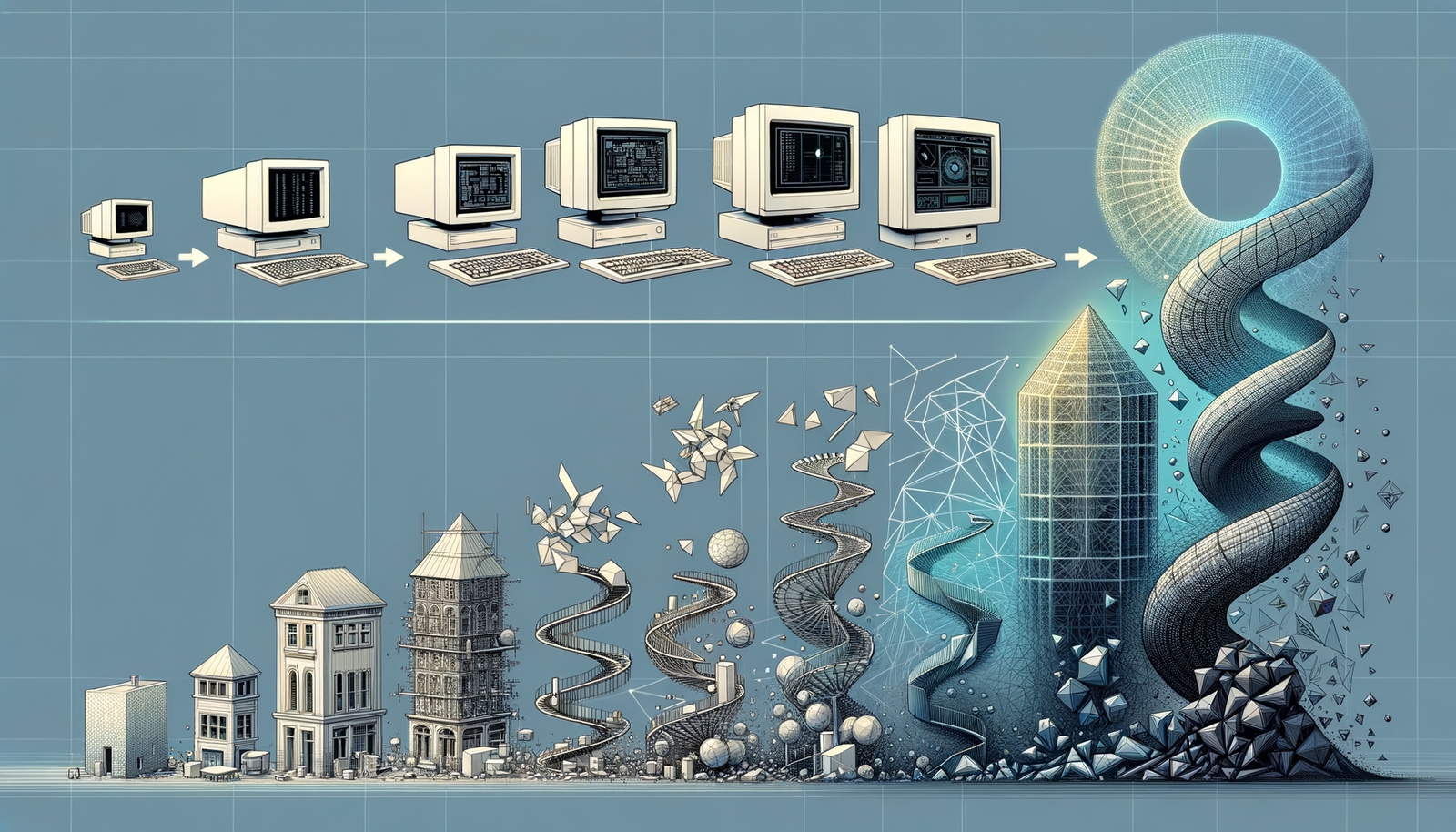Your Cart is Empty
Customer Testimonials
-
"Great customer service. The folks at Novedge were super helpful in navigating a somewhat complicated order including software upgrades and serial numbers in various stages of inactivity. They were friendly and helpful throughout the process.."
Ruben Ruckmark
"Quick & very helpful. We have been using Novedge for years and are very happy with their quick service when we need to make a purchase and excellent support resolving any issues."
Will Woodson
"Scott is the best. He reminds me about subscriptions dates, guides me in the correct direction for updates. He always responds promptly to me. He is literally the reason I continue to work with Novedge and will do so in the future."
Edward Mchugh
"Calvin Lok is “the man”. After my purchase of Sketchup 2021, he called me and provided step-by-step instructions to ease me through difficulties I was having with the setup of my new software."
Mike Borzage
Design Software History: Docker's Impact on Design Software: Historical Challenges, Transformative Solutions, and Future Innovations
August 24, 2024 5 min read


Introduction to Docker and Its Importance in Design Software
Overview of Docker
Docker is a platform designed for developing, shipping, and running applications. It utilizes containerization technology to enable applications to run consistently across different computing environments. Docker's inception marked a significant leap in how software developers handle the complexities of modern application deployment.
At its core, Docker encapsulates an application and its dependencies into a container. This container can then be moved and executed reliably on any system with Docker installed, eliminating the longstanding issues of "it works on my machine" syndrome. This approach ensures that the application behaves the same regardless of where it's deployed, whether on a developer's laptop, on-premise data center, or in the cloud.
Significance in Design Software
The deployment of design software has historically been plagued by numerous issues, such as dependency conflicts, environment inconsistencies, and scalability challenges. Docker addresses these issues by providing a consistent and reproducible environment for running applications.
One of the primary benefits of Docker in the context of design software is **consistency**. Containers ensure that the environment remains the same across various stages of development, from coding to testing and production. This consistency reduces bugs and unexpected behavior caused by environment differences.
Additionally, Docker enables **scalability**. Design software often requires significant computational resources, and Docker allows for efficient scaling across multiple machines or cloud instances. The ease of management provided by Docker also streamlines the deployment process, minimizing downtime and simplifying maintenance activities.
Purpose of the Article
This article aims to explore Docker's transformative role in the deployment and management of design software. We will delve into Docker's history and its impact on the design software industry, highlighting key historical milestones and significant implementations. Furthermore, we will examine the future prospects and innovations in Docker that continue to shape the landscape of design software.
Early Challenges in Design Software Deployment
Traditional Deployment Methods
Before the advent of containerization, design software deployment relied heavily on traditional methods. These methods included manual installation processes, virtual machines, and complex configuration scripts. While these approaches served their purpose, they were fraught with challenges that hindered efficient deployment and management.
One of the most common issues with traditional deployment methods was **dependency conflicts**. Different applications and software components often required specific versions of libraries and dependencies. Ensuring compatibility between these dependencies was a labor-intensive and error-prone process.
Another significant challenge was **environment inconsistencies**. The development, testing, and production environments often differed in terms of configuration, operating system, and installed software. This disparity led to bugs and unexpected behavior when software moved from one environment to another.
Case Studies
Design software companies frequently encountered specific challenges with traditional deployment methods. Industry professionals testified to the limitations and frustrations these methods imposed.
For instance, a lack of uniformity across different environments often resulted in prolonged debugging sessions. Developers faced the daunting task of replicating production issues on their local machines, a process that could consume valuable time and resources.
Moreover, scaling design software to meet increasing demand was cumbersome with traditional methods. The manual nature of deployment made it difficult to efficiently allocate resources and maintain high availability. These challenges collectively underscored the need for a more streamlined and consistent deployment approach.
The Advent of Docker and Its Adoption in Design Software
Introduction of Docker
Docker was introduced in 2013 by Solomon Hykes and the team at dotCloud. It emerged as a revolutionary solution to the longstanding problems associated with software deployment and environment management.
The initial reception of Docker was overwhelmingly positive, with developers and organizations quickly recognizing its potential. Early adopters embraced Docker for its ability to simplify the deployment process and ensure environment consistency. The platform's open-source nature further fueled its rapid adoption and community-driven innovation.
Transformation in Design Software Industry
Leading design software companies, such as Autodesk and Dassault Systèmes, were among the early adopters of Docker. These companies leveraged Docker's capabilities to transform their deployment processes and enhance the efficiency of their operations.
For example, Autodesk utilized Docker to containerize their design software applications, enabling consistent deployment across various environments. This approach reduced the friction between development and operations teams, resulting in faster release cycles and improved software quality.
Dassault Systèmes, known for their cutting-edge CAD and PLM software, also embraced Docker to streamline their development pipelines. By containerizing their applications, they achieved greater scalability and flexibility, allowing them to respond swiftly to changing market demands.
These success stories underscore the profound impact of Docker on the design software industry. Docker's ability to address common deployment challenges and enhance operational efficiency has solidified its place as a pivotal tool in the development and management of design software.
Future Prospects and Innovations
Ongoing Developments
The field of containerization and orchestration technologies continues to evolve, with Docker at the forefront of these developments. One notable trend is the integration of Kubernetes, an open-source container orchestration platform, with Docker.
Kubernetes complements Docker by providing advanced orchestration capabilities, such as automated scaling, load balancing, and self-healing. This powerful combination enables design software companies to manage complex containerized applications with ease, ensuring high availability and optimal performance.
Moreover, Docker continues to innovate with features such as Docker Compose and Docker Swarm, which simplify the management of multi-container applications. These tools enhance the developer experience and streamline the deployment of complex design software systems.
Future Challenges and Opportunities
Despite its numerous benefits, Docker adoption is not without challenges. **Security concerns** remain a critical consideration, as containerized applications can potentially introduce vulnerabilities if not properly managed.
Large-scale deployments also present complexities in terms of orchestration and resource allocation. Ensuring seamless communication and coordination between containers requires robust tools and expertise.
However, these challenges also present opportunities for further innovation. The integration of Docker with emerging technologies such as artificial intelligence (AI), machine learning (ML), and the Internet of Things (IoT) holds immense potential. These technologies can enhance the capabilities of design software, enabling more sophisticated simulations, predictive analytics, and real-time monitoring.
Looking ahead, the continued evolution of Docker and its ecosystem will likely lead to even more streamlined and efficient deployment processes. As the design software industry continues to embrace containerization, the future landscape holds promise for greater innovation and improved user experiences.
Conclusion
In conclusion, Docker has played a transformative role in the design software industry, addressing longstanding challenges and enabling more efficient deployment and management processes. From its inception in 2013 to its widespread adoption by leading design software companies, Docker has proven to be a pivotal tool in the modern software development landscape.
As we look to the future, the ongoing developments in containerization and orchestration technologies, coupled with the integration of emerging technologies, will continue to shape the deployment and management of design software. Docker's impact on the industry is undeniable, and its potential for driving further innovation remains promising.
The design software industry stands at the forefront of technological advancement, and Docker's contributions have paved the way for a more streamlined, scalable, and consistent approach to software deployment. As we move forward, the synergy between Docker and design software will undoubtedly continue to drive progress and innovation.
Also in Design News

Harnessing Advanced Nesting Algorithms for Sustainable Material Optimization in Design and Manufacturing
November 27, 2024 9 min read
Read More
Design Software History: The Evolution and Impact of Parametric Modeling in Design Software History
November 27, 2024 6 min read
Read More
ZBrush Tip: Maximize ZBrush Workflow Efficiency with Subtool Master Techniques
November 26, 2024 2 min read
Read MoreSubscribe
Sign up to get the latest on sales, new releases and more …


